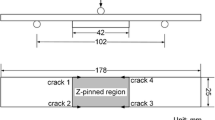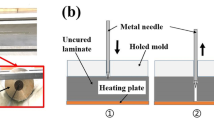Abstract
Composite skin-stringer structures are widely used in engineering, and the Z-pinning technology is employed to attach the skin-stringer structure to prevent it from debonding. In this paper, we propose a low-in-plane damage ZPI (Z-pin pre-hole insertion) technology for fabricating a simplified skin-stringer joint to investigate the tensile and impact properties of a Z-pinned skin-stringer structure. What’s more, the failure modes and the toughening mechanism of the specimen have been analyzed. It is found that the ZPI process can reduce the likelihood of fiber crushing and breaking. In addition, the reduced Z-pin inclination angle of the ZPI process can reduce crack initiation and expansion at the bonded interface. The tensile tests reveal that a thicker Z-pin is more beneficial for improving the total energy absorption, while the thinner Z-pin is better for failure displacement at the same Z-pin volume content. Moreover, the use of 0° ply should be limited during the layer design. The impact tests show that the Z-pinning bridging effect is insignificant or even deteriorates under the high-speed impact. Z-pinning can also lessen deflection after impact and improve impact resistance. However, Z-pinning has little effect on the amount of impact energy absorbed by the specimen. Furthermore, Z-pins can effectively inhibit mode II crack propagation by fracturing themselves to making GIIC significantly higher, but when the specimen is penetrated, Z-pins cannot form a large bridging zone, and the snubbing effect is not evident. These results can provide some guidance for fabricating the Z-pinned skin-stringer joint.































Similar content being viewed by others
Data Availability
The raw/processed data required to reproduce these findings cannot be shared at this time as the data also forms part of an ongoing study.
References
Sonnenfeld, C., Mendil-Jakani, H., Agogué, R., Nunez, P.: Thermoplastic/thermoset multilayer composites: a way to improve the impact damage tolerance of thermosetting resin matrix composites. Compos. Struct 171, 298–305 (2017)
Jiuyang, Y.U., Zhonghao, W., Qi, C., Yazhong, X.I.A.: Study on properties of advanced resin matrix composites for valve body manufacturing. China Plast 36(8), 16–22 (2022)
Zhang, X.Y.: The Mechanical Performance and Failure Mechanism of Z-pin Reinforced Composite Skin/Stiffener Structures. Nanjing University of Aeronautics and Astronautics, China (2017)
van Dooren, K.S., Tijs, B., Waleson, J.E.A., Bisagni, C.: Skin-stringer separation in post-buckling of butt-joint stiffened thermoplastic composite panels. Compos. Struct 304(2), 116294 (2023)
Noh, J.S., Ghim, Y.T., Shin, J.H., Kwon, B.S.: Buckling characteristics of skin-stringer composite stiffened panel. J. Aerosp. Syst. Eng 14(6), 68–73 (2020)
Mei, B., Wang, H., Zhu, W.: Pose and shape error control in automated machining of fastener holes for composite/metal wing-box assembly. J. Manuf. Process 66, 101–114 (2021)
Acanfora, V., Petillo, R., Incognito, S., Mirra, G.M., Riccio, A.: Development of detailed FE numerical models for assessing the replacement of metal with composite materials applied to an executive aircraft wing. Aerospace 8(7), 178 (2021)
Feistauer, E.E., dos Santos, J.F., Amancio-Filho, S.T.: A review on direct assembly of through-the‐thickness reinforced metal–polymer composite hybrid structures. Polym. Eng. Sci 59(4), 661–674 (2019)
Liu, L.S., Wang, P., Legrand, X., Soulat, D.: Investigation of mechanical properties of tufted composites: influence of tuft length through the thickness reinforcement. Compos. Struct 172, 221–228 (2017)
Neale, G., Skordos, A.: Insertion of large diameter through-thickness metallic pins in composites. Mater Des 216, 110599 (2022)
Hui, C., Chen, C., Legrand, X., Wang, P.: Investigation of the interlaminar shear performance of tufted preforms and composites under Mode II loading condition. Polymers 14, 690 (2022)
Shen, H., Wang, P., Legrand, X.: In-plane shear characteristics during the forming of tufted carbon woven fabrics. Compos. Part. A 141, 106196 (2021)
Verma, K.K., Viswarupachari, C.H., Viswamurthy, S.R., Kotresh, M., Gaddikeri, S.K.: Effect of tufting on mechanical performance of co-cured co-infused carbon-epoxy composite T-joint. Compos. Struct 250, 112468 (2020)
Greenhalgh, E., Lewis, A., Bowen, R., et al.: Evaluation of toughening concepts at structural features in CFRP-Part I: stiffener pull-off. Compos. Part. A 37(10), 1521–1535 (2006)
Koh, T.M., Isa, M.D., Chang, P., et al.: Improving the structural properties and damage tolerance of bonded composite joints using Z-pins. J. Compos. Mater 46(26), 3255–3265 (2012)
Wang, X., Chen, W., Tang, Y.: Understanding meso interfacial structures between Z-pins and laminates in Z-pinned laminates. Compos. Commun 35, 101313 (2022)
Javier, T.V., Bruno, C., Jean-Jacques, B., et al.: Multi-level analysis of low-cost Z-pinned composite joints part 2 joint behaviour. Compos. Part. A 42(2), 2082–2092 (2011)
Krueger, R., Cvitkovich, M.K., Kevin, O.T.: Testing and analysis of composite skin/stringer debonding under multi-axial loadinging. J. Compos. Mater 34(15), 1263–1300 (1999)
Yoshimura, A., Nakao, T., Yashiro, S., Takeda, N.: Improvement on out-of-plane impact resistance of CFRP laminates due to through-the-thickness stitching. Compos. A 39, 1370–1379 (2008)
Francesconi, L., Aymerich, F.: Effect of Z-pinning on the impact resistance of composite laminates with different layups. Compos. Part. A 114, 136–148 (2018)
Hou, Y.L., Tie, Y., Li, C., Meng, L., Sapanathan, T., Rachik, M.: On the damage mechanism of high-speed ballast impact and compression after impact for CFRP laminates. Compos. Struct 229, 111435 (2019)
Ramaswamy, K., O’Higgins, R.M., McCarthy, C.T.: Impact damage tolerance and residual performance of novel interlocked-hybrid structural joints. Compos. Part. B 241, 109996 (2022)
Feng, Y., He, Y., Tan, X., Zheng, J.: Experimental investigation on different positional impact damages and shear-after-impact (SAI) behaviors of stiffened composite panels. Compos. Struct 178, 231–245 (2017)
Chenghu, L., Ying, Y., Yubo, C., Desheng, Q., Yonghai, W.: Experiment and simulation study on tensile properties of Z-pinned composite laminates. Acta Aeronaut. Astronaut. Sin. 31(12), 2435–2441 (2010)
Mouritz, A.P.: Review of Z-pinned laminates and sandwich composites. Compos. Part. A 139, 106–128 (2020)
Mouritz, A.P.: Review of Z-pinned composite laminates. Compos. Part. A 38(12), 2383–2397 (2007)
Yasaee, M., Lander, J.K., Allegri, G., et al.: Experimental characterisation of mixed mode traction–displacement relationships for a single carbon composite Z-pin. Compos. Sci. Technol 94, 123–131 (2014)
Vassilis, K., Nikolaos, S., Stavros, T.: Review of through-the-thickness reinforced Z-pinned composites. J. Compos. Sci 31(4), 1–41 (2020)
Cui, H., Melroc, A.R., Yasaeea, M., et al.: Inter-fibre failure of through- thickness reinforced laminates in combined transverse compression and shear loading. Compos. Sci. Technol 165(6), 48–57 (2018)
Zhang, X.Y., Li, Y., Chu, Q.Y., et al.: Influence of Z-pin distribution on the in-plane compression performance of laminates. Chin. J Aeronaut 35(1), 195–202 (2014)
Gong, B., Wenting, O., Martinson, N.: Minimizing the in-plane damage of Z-pinned composite laminates via a pre-hole pin insertion process. Compos. Sci. Technol 200(13), 1481–1491 (2020)
Sweeting, R.D., Thomson, R.S.: The effect of thermal mismatch on Z-pinned laminated composite structures. Compos. Struct 66(1–4), 189–195 (2004)
Park, Y.B., Lee, B.H., Kweon, J.H., et al.: The strength of composite bonded T-joints transversely reinforced by carbon pins. Compos. Struct 94(2), 625–634 (2012)
Chang, P., Mouritz, A.P., Cox, B.N., et al.: Properties and failure mechanisms of Z-pinned laminates in monotonic and cyclic tension. Compos. Part. A 37(10), 1501–1531 (2006)
Zhang, X., Hounslow, Grassi, L.: Improvement of low-velocity impact and compressionafter-impact performance by Z-fibre pinning. Compos. Sci. Technol 66(15), 2785–2794 (2006)
Stringer, L.G., Hiley, M.J.: Through-thickness reinforcement of composites: z-pinning, stitching and 3-D weaving. Proceedings of the14th International Conference Oncomposite Materials, San Diego (2003)
Partridge, I.K., Cartie´, D.D.R., Troulis, M., Grassi, M., Zhang, X.: Evaluating the mechanical effectiveness of Z-pinning. Proceedings of the SAMPE Technical Conference (2004)
Zheng, X.T.: Research progress of composite interlaminar properties improvement methods. Aerosp. Manuf. Technol 15, 26–29 (2013)
Acknowledgements
This work was supported by the Key Technology Research of Composite Fan Blade Molding Process Program (KF050056) through the AVIC Composite Material Co., Ltd., funded by the State Administration of Science, Technology, and Industry for National Defence, PRC (China). Thanks to the Key Laboratory of the Ministry of Industry and Information Technology for High Performance Manufacturing of Aero Engines (Northwestern Polytechnical University).
Author information
Authors and Affiliations
Corresponding author
Ethics declarations
Conflict of Interest
No potential conflict of interest was reported by the author(s).
Additional information
Publisher’s Note
Springer Nature remains neutral with regard to jurisdictional claims in published maps and institutional affiliations.
Rights and permissions
Springer Nature or its licensor (e.g. a society or other partner) holds exclusive rights to this article under a publishing agreement with the author(s) or other rightsholder(s); author self-archiving of the accepted manuscript version of this article is solely governed by the terms of such publishing agreement and applicable law.
About this article
Cite this article
Liu, W., Jin, K., Li, X. et al. Effect of Z-Pinning on the Tensile and Impact Properties of Skin-Stringer via a ZPI (Z-Pin Pre-Hole Insertion) Process. Appl Compos Mater 30, 607–633 (2023). https://doi.org/10.1007/s10443-023-10104-0
Received:
Accepted:
Published:
Issue Date:
DOI: https://doi.org/10.1007/s10443-023-10104-0




